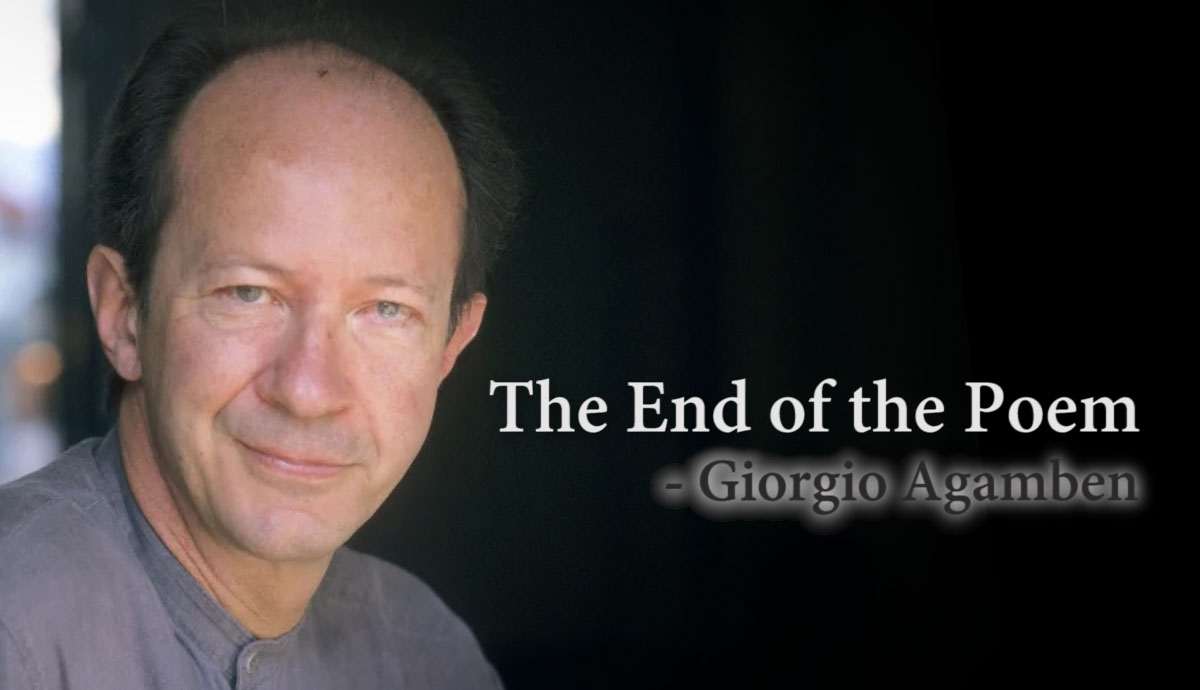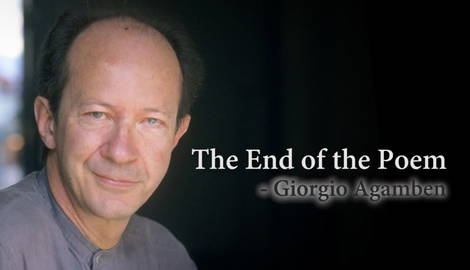
How should poems end? Do poems, by ending, consign their content to irrelevance? Do poems revoke whatever message or meaning they had with an imperfect ending? Giorgio Agamben’s succinct essay The End of the Poem raises these issues in order to focus attention onto some more fundamental concerns: in particular, how poetry in general should be defined.
This article begins with a brief biographical note on Agamben, before examining just why it is that Agamben focused on the end of the poem in the first place. It then investigates two of the main concepts Agamben’s analysis deploys – semiotics and semantics. This article then concludes with a discussion of Agamben’s ultimate solution to how poems should end – namely, in silence – and of why this is the answer which he gives
Who is Giorgio Agamben?

Giorgio Agamben is a contemporary theorist known both for the diversity of his intellectual interests and the asymmetry of his own intellectual development. He was born in Rome in 1942, and as a young man participated in a series of seminars held by the German philosopher Martin Heidegger at Le Thor in Provence, focused on the work of Heraclitus and Hegel.
He was greatly influenced by the work of the German writer and critic Walter Benjamin, who Agamben famously credited with helping him to ‘survive Heidegger’. Agamben’s thesis was on the work of Simone Weil, French philosopher and mystic, and he has since become best known as a political theorist of sorts. Agamben was friends and sometime intellectual collaborators with a variety of great writers (among them Italo Calvino) and artists, and both poetry and poetics (the study of poetry) have been abiding interests throughout his career.
Why focus on the end of the poem? It is a deceptively difficult question. The first important point of context is that poems do not end in the same way, or even similar ways. It is possible to point out poems which are nothing but their ending – in other words, the end of the poem is what makes the poem as a whole worthwhile, intelligible or beautiful. There are equally many poems which simply stop, or appear abandoned. Some poems are fragments, others are systems, most are neither. Addressing the end of the poem forces one to address the question of resemblance in poetry as such. Can one speak generally about poetry?
Poetic Difference

At certain points, Agamben appears to be speaking only to a certain kind of poetry, with a certain kind of structure. Sometimes, poetry is understood as having a determinate metrical structure. What is metre? Metre is rhythmic structure, having to do with how stress or emphasis is placed.
Now, clearly stress or emphasis is not an element of poetry alone, but traditionally poets would pay far greater attention to metrical structure than those writing prose. Many poets have their distinctive metrical structures and certain metrical structures are distinctive of the poetry written at a certain time and place. If a rigid rhythmical structure once served to distinguish poetry from prose, that distinction now seems to be antiquated. Many modern poets do not write in such a rigid structure, and indeed many poets experiment with intermediary forms.
Agamben’s focus on metre should be understood in context. He addresses the end of the poem in a collection of essays on poetry, many of which focus on medieval Italian and Occitan poetry, which did have a fairly rigid metrical structure. Metrical structure can, for our purposes, be understood as referring to the sonorous element of poetry. Agamben is interested in analyzing how and how far poetry can be understood as a divergence of sound and sense. And yet the picture is more complicated than that, given that Agamben associates sound with semiotics and sense with semantics.
The Role of Semiotics

What is semiotics? Broadly, semiotics is the study of signs and the interpretation of signs, but there are various competing specific meanings of the term. One of Agamben’s major interests is in the work of Ferdinand de Saussure, a linguist whose work is still considered of great interest in many of the human sciences. De Saussure defined semiotics (or, as he calls it, semiology) in the following way:
“It is…possible to conceive of a science which studies the role of signs as part of social life. It would form part of social psychology, and hence of general psychology. We shall call it semiology (from the Greek semeîon, ‘sign’). It would investigate the nature of signs and the laws governing them. Since it does not yet exist, one cannot say for certain that it will exist. But it has a right to exist, a place ready for it in advance. Linguistics is only one branch of this general science. The laws which semiology will discover will be laws applicable in linguistics, and linguistics will thus be assigned to a clearly defined place in the field of human knowledge.”
It is the idea that signs have governing laws which is of interest in this quote. That the relations between sounds in a poem signify something is absolutely critical to understanding Agamben’s argument about the relationship between sound and sense. If the way a poem sounds means nothing, then no divergence between sound and sense is possible.
The Role of Semantics

What of semantics? Semantics simply refers to the study of meaning, but again this develops different, specific connotations in different contexts. Agamben understands the semantic element of the poem as something like its ‘literal’ meaning – the bare conveyance of the words understood straightforwardly, as opposed to the meaning conveyed by the structure of sound in the poem.
We can now understand another way in which Agamben seeks to distinguish the poem from other forms of writing. Enjambment can only occur in a poem. Enjambment is simply when one line of a poem runs onto the next line. As Agamben points out, enjambment represents the divergence of sound and sense, insofar as the line breaks correspond to the sonic structure of the poem whereas the lines running on shows a continuity in the meaning of the poem.
Now we can return to the initial question – why focus on the end of the poem? In short, because the end of the poem is the only part in which by definition enjambment cannot occur – sound and meaning come to an end at precisely the same time. This convergence seems to run against the characterization of poems as defined by the tension between sound and meaning. Does every poem become prose by the very end?
The Importance of Silence According to Giorgio Agamben

Agamben responds to this problem in a number of ways, but the answer he comes to is that the solution lies in silence.
“Let us now reread what Dante says about the most beautiful way to end a poem, the place in which the last verses fall, rhymed, in silence… It is as if the verse at the end of the poem, which was now to be irreparably ruined in sense, linked itself closely to its rhyme-fellow and, laced in this way, chose to dwell with it in silence. This would mean that the poem falls by once again marking the opposition between the semiotic and the semantic, just as sound seems forever consigned to sense and sense returned forever to sound. The double intensity animating language does not die away in a final comprehension; instead it collapses into silence, so to speak, in an endless falling”.
What is the importance of silence in a poem? Silence is the difference between syllables, in that it is what differentiates one sound from another. It is also ambiguous between the end and an uninterrupted flow.
Earlier in this essay, Agamben referred to another way of ending the poem: that one should construct a formal designation of where the poem ends, a kind of signpost for the reader. What is the point of such a structure? It would, in effect, amount to an apology for the absence of enjambment, one which encourages the reader not to misunderstand the end of the poem as having intentionally descended into prose. It would, in short, preserve the tension between sound and sense on which poetry flourishes.
What would be so wrong with poetry which ended with sound and sense reconciling or converging? Agamben concludes his essay by answering this very question in the following way: “poetry…is threatened by an excess of tension and thought”. In other words, the tension can neither be resolved nor climax at the end of the poem, if it is to remain free from banality or irrelevance. Only a formal resolution or silence will preserve a poem’s significance.










